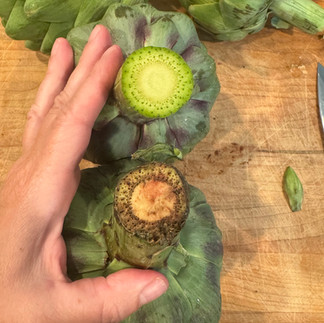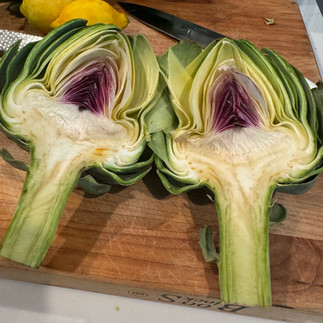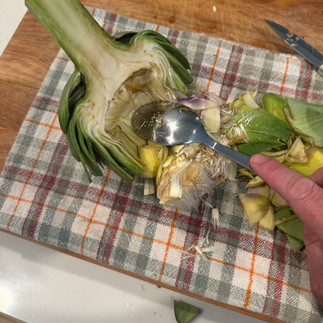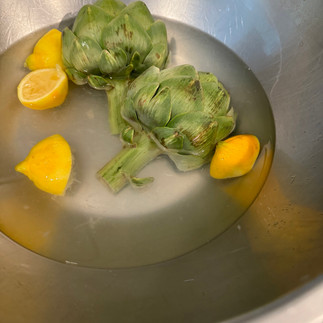Nothing Stuffy About Stuffed Artichokes
- CarolOfMoon

- Aug 22, 2024
- 5 min read

I guess I like to work for my food.
I’ll take peel and eat shrimp over shrimp cocktail.
My favorite past time? Picking and eating Maryland blue crabs. 🦀
Everyday.
Pistachios with shells any day of the week.
Twice on Tuesdays.
So it’s easy to see why stuffed artichokes happen to be in my wheel house.
No, I don’t mean the canned variety. Not even the jarred ones.
I mean the globe like green outer leaves, or scales— thick and rigid, serrated, spiny edges with a rough texture and often a slightly purplish tinge near the tips.
Yeah, those ones.

Artichokes are typically harvested in the spring and early summer, with the peak season varying depending on the region. In regions with mild winters, they can also produce a second crop in the fall.
But I got mine mid summer.
And let me tell you, they were very fresh!
And that has to do with quiet transformations happening in California.
Over the last two decades, the beloved California artichoke has undergone a radical transformation.
Nearly two-thirds of the world’s artichokes are grown in Monterey County, which is home to the town of Castroville, dubbed the “Artichoke Capital of the World.” This region, where the rich, fertile soil of the Salinas Valley meets the sands of Monterey Bay, provides the optimal growing conditions for artichokes year-round.
Commonly revered for its umami nuttiness and big tender heart — the “Green Globe heirloom” is a vanishing breed, raised now on just a few hundred acres in Castroville, CA. Grown from the same root stock imported by Italian immigrants a century ago, this heirloom once dominated tens of thousands of acres in Monterey County.
What has been developed is a hybrid.
Hybrid artichokes grown in California typically refer to varieties that are bred for specific desirable traits, such as higher yields, improved disease resistance, or better adaptation to local growing conditions. California's climate, particularly in regions like the central coast, is ideal for artichokes, which thrive in the mild, Mediterranean-like conditions.
Some well-known hybrid artichoke varieties include:
'Imperial Star': Known for its high yields and adaptability to different climates.
'Green Globe': A common variety that’s appreciated for its large, tender buds.
'Violet de Provence': Renowned for its unique color and taste.
These hybrids often have characteristics that enhance their growth and productivity in California’s agricultural environment.
Cooking Class with Carol
As a kid growing up in a Polish household, an artichoke was a foreign vegetable. I could tell you anything you wanted to know about cabbage. But artichokes, nothing.
At my sister’s friend’s Italian household, they would be found.
Whole trimmed artichokes stuffed with a delicious bread crumb filling — I never would imagine anchovy was in it. And if I did, I’m sure I wouldn’t have tried them.
Anne Marie Piazza, now Annie Shaw of Moon Township recently gave me her parent’s stuffed artichoke recipe. I am honored!
Her mother, Loretta “Dolly" was from the Abruzzi region of Italy. Biagio "Ben" Piazza, her father, immigrated from Sicily.
They would eat artichokes in the spring, as a special treat during Easter. And their recipe was reminiscent of how Sicilians eat them to this day.
Annie remembers the pain staking tasks her mom and aunts would go through to prepare the artichokes. Clipping leaves, boiling, stuffing and baking. But the reward is so worth the effort.
She hasn't made them for some time- so I was thrilled when she shared her story and recipe with me. And joined me in the kitchen to prepare the artichokes.

Artichokes Italian History
Artichokes (have a rich history in Italy that dates back to ancient times. The artichoke, known scientifically as Cynara scolymus, is native to the Mediterranean region. Its cultivation and use were well established by the time of the Romans.
The artichoke was cultivated by the Romans, who valued it for its culinary and medicinal properties. It was considered a luxury food item and was mentioned in writings by authors like Pliny the Elder.
During the medieval period, the artichoke was less prominent in Italian cuisine. However, it began to gain more recognition in the 14th and 15th centuries as European gardens started to include more exotic vegetables.
The artichoke saw a revival during the Renaissance, especially in the regions of Italy where wealthy families cultivated elaborate gardens. It became a symbol of wealth and sophistication.
By the 18th century, the artichoke had become a staple in Italian cuisine, particularly in regions like Rome and Sicily. Its popularity grew as Italian culinary traditions became more diverse and sophisticated.
Today, artichokes are a key ingredient in many Italian dishes, from antipasti to pasta. Italy is known for its wide variety of artichoke preparations, including the famous Roman-style artichokes (carciofi alla Romana) and fried artichokes (carciofi alla giudia).
We will be making the Piazza’s Carciofi Imbottiti alla Siciliana— Sicilian stuffed artichokes
What Do Artichokes Taste Like?
Artichokes have a unique and nuanced flavor. Their taste is often described as a blend of earthy, nutty, and slightly sweet notes with a hint of bitterness. The texture can vary from tender and creamy when cooked to slightly fibrous in the outer leaves. The flavor can also be somewhat tangy or herbal, depending on how they are prepared. When cooked properly, artichokes develop a rich, savory quality that complements many dishes.
Be certain to cook artichokes until fork tender. You will include them in your cooking repertoire!
Recipe

6 large-sized globe artichokes
1-1/2 cups fresh bread crumbs
1 clove garlic, minced or crushed
1 small onion, minced (about 1/3 cup)
2 anchovy fillets, minced
2 tbsps. minced, flat Italian parsley
1/4 cup freshly grated Romano cheese
1/2 tsp. salt
1/2 tsp. pepper
2/3 cup olive oil
4-5 lemons, zested and juiced
•Prepare an acidulated water bath for the cut artichokes. In a large bowl, add one quart of water to the juice of the lemons.
•Cut off small tip of artichoke stems, making a flat bottom.
•Cut off 1/3 of top of artichoke.
•Trim points of leaves with kitchen shears.
•Cut in half.
•Gently position a large spoon in the scored heart and remove choke.
Using a vegetable peeler and remove all of the stringy fibrous part of stalk. Place artichokes back in acidulated water (lemon water) to stop oxidation and browning of the artichoke heart and flesh.
In a food processor, combine bread crumbs, garlic, onion, anchovies, parsley, cheese, salt, and pepper, lemon zest with 1/3 cup oil.
Pulse until well incorporated.
Stuff between the loosened leaves and in the center of the artichokes. Place artichokes sideways on a large baking tray or dish.
Pack them together so they won't tip over. Drizzle with the remaining oil.
Cover tightly and bake at 350 degrees for 40 minutes, or until fork tender.

Start with the heart and eat all tender parts of heart and stem. As you finish the heart, continue with the leaves pulling them off and scraping teeth across the leave to eat the stuffing and soft edible base of leaf.
Enjoy!



























































Comments